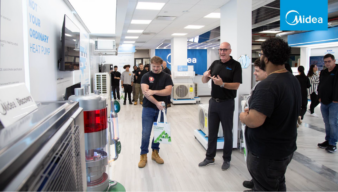Washington, D.C. — More than 1.57 million Americans live without a toilet or tap at home, costing the U.S. economy $8.58 billion every year, according to a report produced by DigDeep with contributions from partners including the International Association of Plumbing and Mechanical Officials (IAPMO®).
Titled “Draining: The Economic Impact of America’s Hidden Water Crisis,” the report provides an in-depth analysis of the costs and benefits of extending water and sanitation access to every home in the United States. The $8.58 billion annual figure averages out to $15,800 per household in health care, time spent collecting and paying for bottled water, loss of time at work and school, and premature death. The full report is available online at digdeep.org/draining.
Produced by DigDeep, a nonprofit organization working to improve access to clean running water in U.S. communities, the report includes contributions from partners including Altarum, the American Heart Association, Robert Wood Johnson Foundation, and IAPMO. It builds on and reinforces key recommendations from DigDeep’s earlier report on the topic: “Closing the Water Access Gap in the United States: A National Action Plan.”
The report attributes the following statistics to the water access gap:
- $15,800 — the annual cost, per household, to the U.S. economy for each household without access to running water or basic plumbing. It includes health care costs, time spent collecting and paying for bottled water, loss of time at work or school, and premature death.
- 219,000 — the annual number of waterborne illnesses, including Legionella.
- 71,000 — the annual number of cases of mental illness
- 68.7 million — the annual number of work hours lost
- $1 billion — the annual loss in U.S. Gross Domestic Product (GDP)
- 610 — annual premature deaths
- $8.58 billion — total annual cost to the U.S. economy
“While speaking to communities for our 2019 report, we heard devastating stories about impacts to people’s health, employment, leisure time, and general well-being,” DigDeep Founder and CEO George McGraw said. “Now we are finally able to measure the true magnitude of those impacts in real dollars. We must close the water access gap. As this report shows, we can’t afford not to.”
While the water access gap is wide and deep, it is solvable — to the benefit of numerous parties even beyond the individuals and families suffering from a lack of access to water and sanitation. With the passage of the bipartisan Infrastructure Investment and Jobs Acts of 2021, $55 billion in water-specific infrastructure funding is available to be spent over the next five years.
Since much of that investment will be used to upgrade and repair existing systems, DigDeep notes that targeted investments are needed for new access and to close the water gap for good.
The report’s authors suggest the following action steps to solve the problem:
- Expand and refocus federal and state funding. Closing the water access gap requires more funding, more flexibility in funding, and funding for interim solutions and new technologies. These efforts should build on the $55 billion in water-specific funding authorized in the Infrastructure Investment and Jobs Acts of 2021.
- Use data to bring visibility to communities. Currently, no central entity collects data on the scope of the U.S. water access gap. Federal data collection must be accompanied by outreach to vulnerable communities to assist them in using data for advocacy and designing solutions.
- Define the water access gap as a crisis. Many countries, and the United Nations, have recognized the urgency of water access by passing resolutions recognizing the human right to water and sanitation. The U.S. federal government should signal its leadership on this issue by doing the same.
- Build a domestic Water, Sanitation, and Hygiene (WaSH) sector. Closing the water access gap will only be possible if led by a dedicated “community of practice” made up of NGOs, funders, research institutions, government agencies, and impacted communities working together toward a shared goal.
“As a technical adviser for this report, IAPMO was pleased to work with the broad coalition of organizations that contributed to this research, and we wholeheartedly endorse these recommendations,” IAPMO Executive Vice President of Government Relations Dain Hansen said. “Access to clean water and safe sanitation is a basic right, and closing the water access gap means advancing equity and righting historical wrongs. IAPMO is proud to be a strong advocate for every community to be able to access the financial and technical resources required to close this water and sanitation access gap.”



